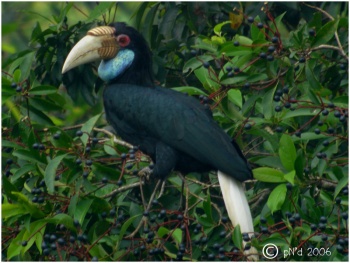Alternative names: Bar-pouched Wreathed Hornbill; Bar-throated Wreathed Hornbill; Northern Waved Hornbill
- Rhyticeros undulatus
Aceros undulatus
Identification
Length 100 cm.
All-black wings contrasting with wholly white tail together with black bar on gular pouch diagnostic. Casque small with ridges. Bill whitish with corrugation on basal sides of maxilla and mandible. Orbital skin red.
Male: Crown and drooping crest brownish; gular pouch yellow; neck white.
Female: Head black, gular pouch pale blue.
In flight the underwings and belly are all-black; together with the white tail, this is distinctive.
Similar species
Larger than Plain-pouched Hornbill. Note also ridges on mandibles and dark bar on throat sac of males.
Distribution
North-east India and Myanmar through South-East Asia to the Greater Sundas and Bali.
Still common in some parts of its range but forest loss has resulted in a patchy distribution.
Taxonomy
This is a monotypic species.
The described subspecies ticehursti (northern mainland range) and aequabilis (Borneo) are normally not accepted.
Sometimes considered conspecific with Plain-pouched Hornbill.
This species has been placed in the genus Aceros.
Habitat
Primary evergreen forest.
Mainly along foothills but occurs also up to 2560m.
Behaviour
Frequents the canopy. Usualy flies in compact flocks of five to eight. Often gathers at fruiting trees together with other species. In flight the wing-beats are continuous, producing a distinct loud and sharp swishing sound. Glides less than other hornbills.
Breeds in a natural hole in a large tree, the female seals the entrance with droppings. Lays 2 eggs but only one chick usually raised.
References
- Clements, JF. 2011. The Clements Checklist of Birds of the World. 6th ed., with updates to August 2011. Ithaca: Cornell Univ. Press. ISBN 978-0801445019. Spreadsheet available at http://www.birds.cornell.edu/clementschecklist/downloadable-clements-checklist
- Del Hoyo, J, A Elliot, and J Sargatal, eds. 2001. Handbook of the Birds of the World. Volume 6: Mousebirds to Hornbills. Barcelona: Lynx Edicions. ISBN 978-8487334306
Recommended Citation
- BirdForum Opus contributors. (2024) Wreathed Hornbill. In: BirdForum, the forum for wild birds and birding. Retrieved 23 May 2024 from https://www.birdforum.net/opus/Wreathed_Hornbill





